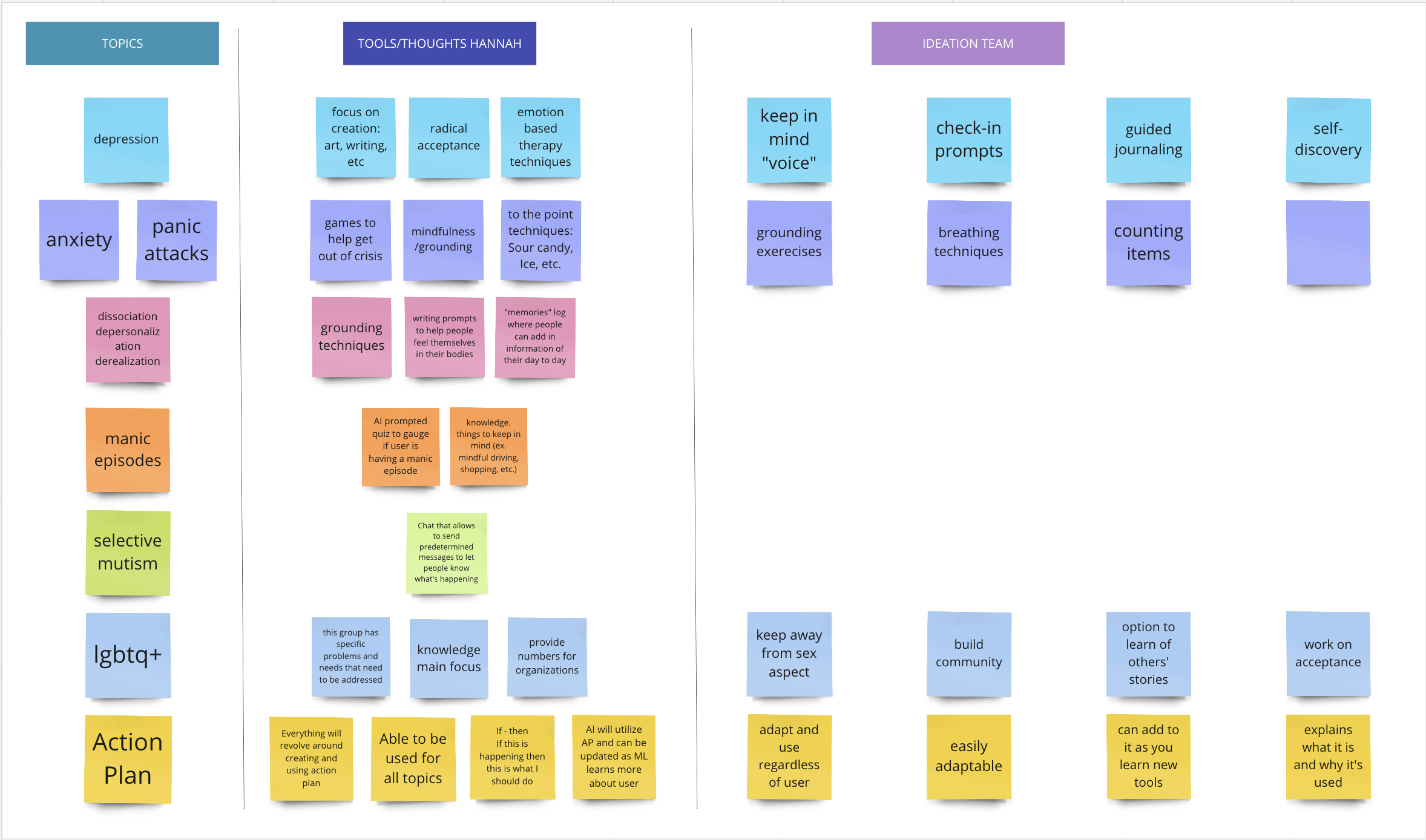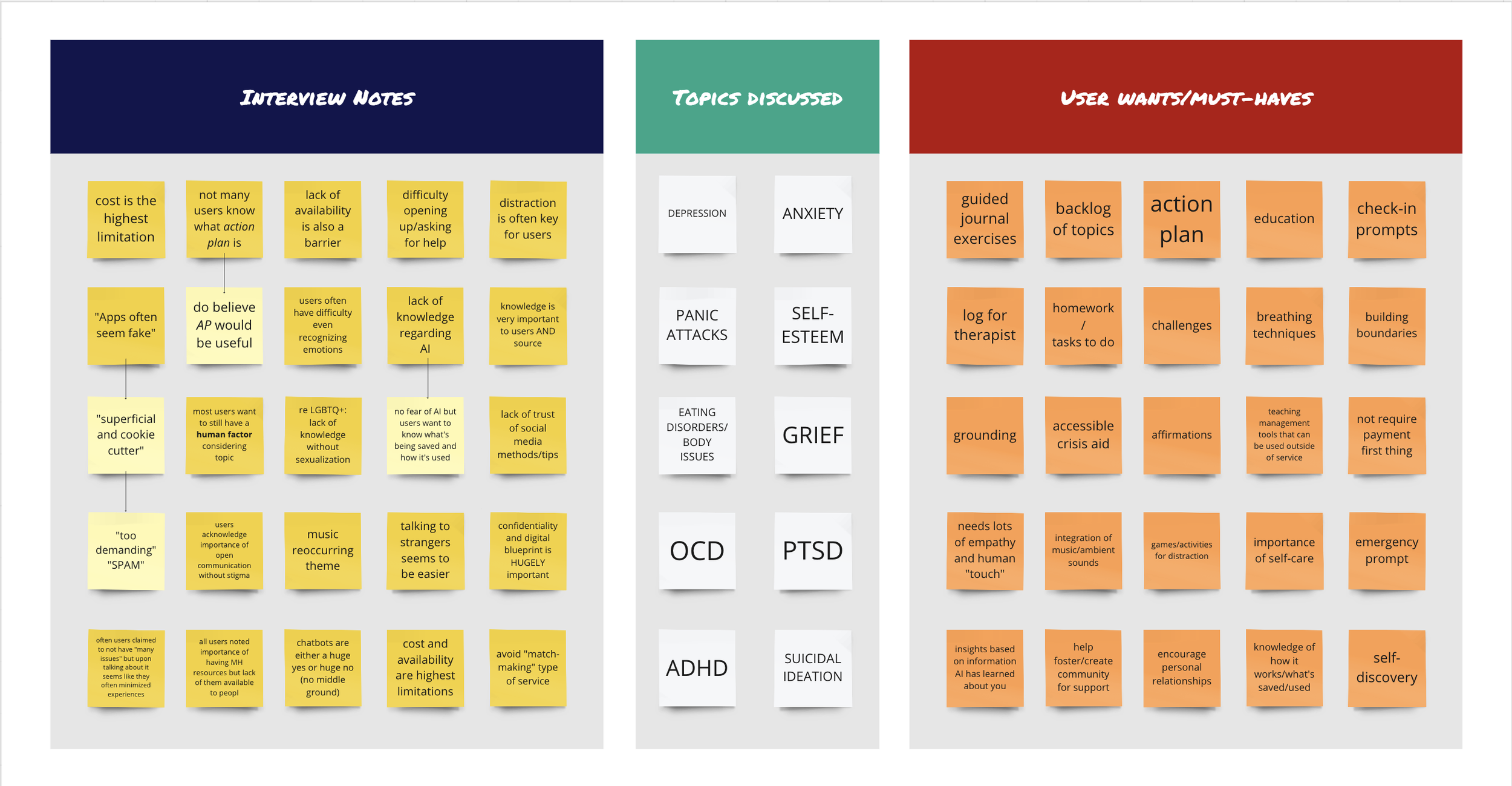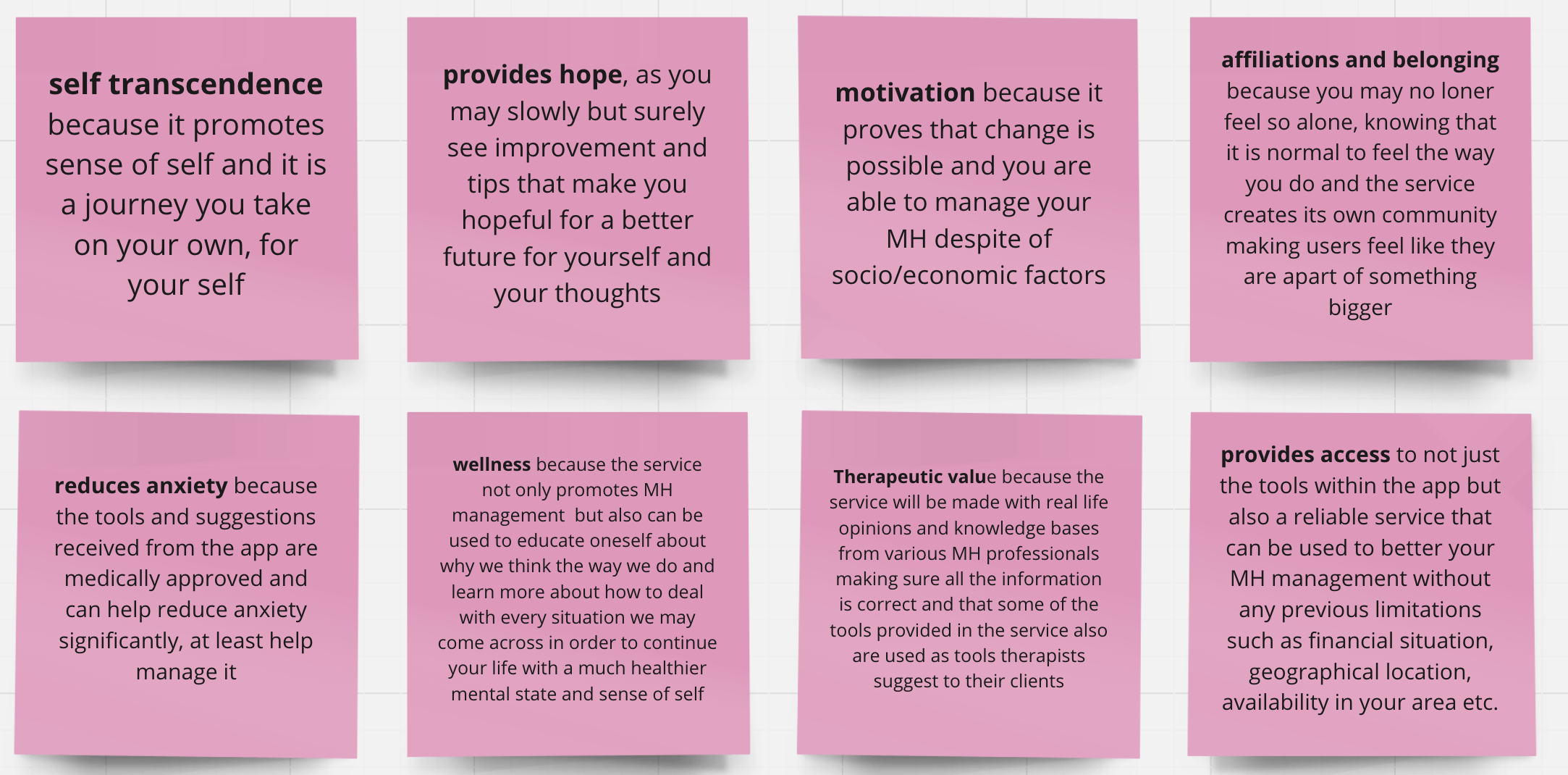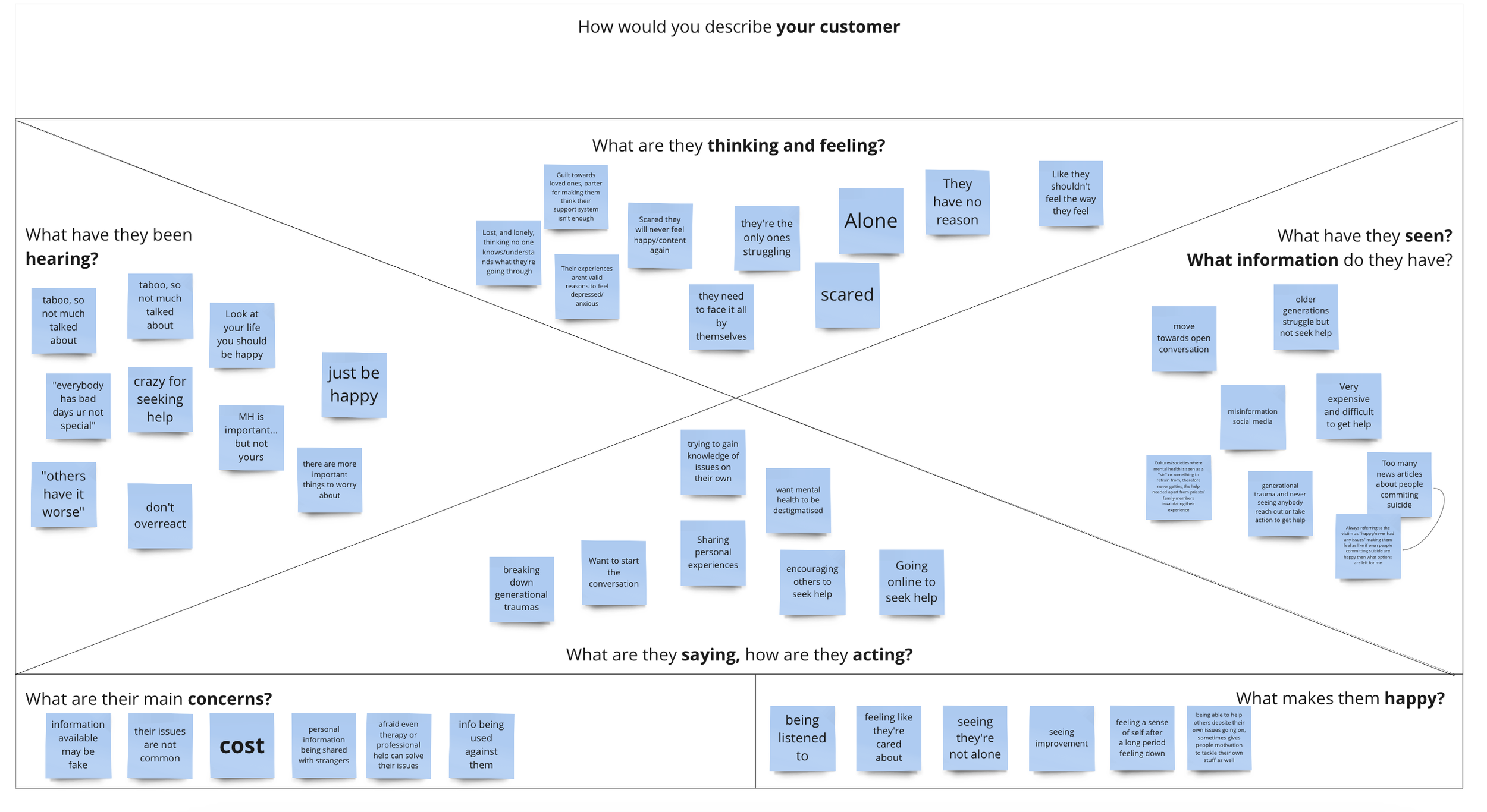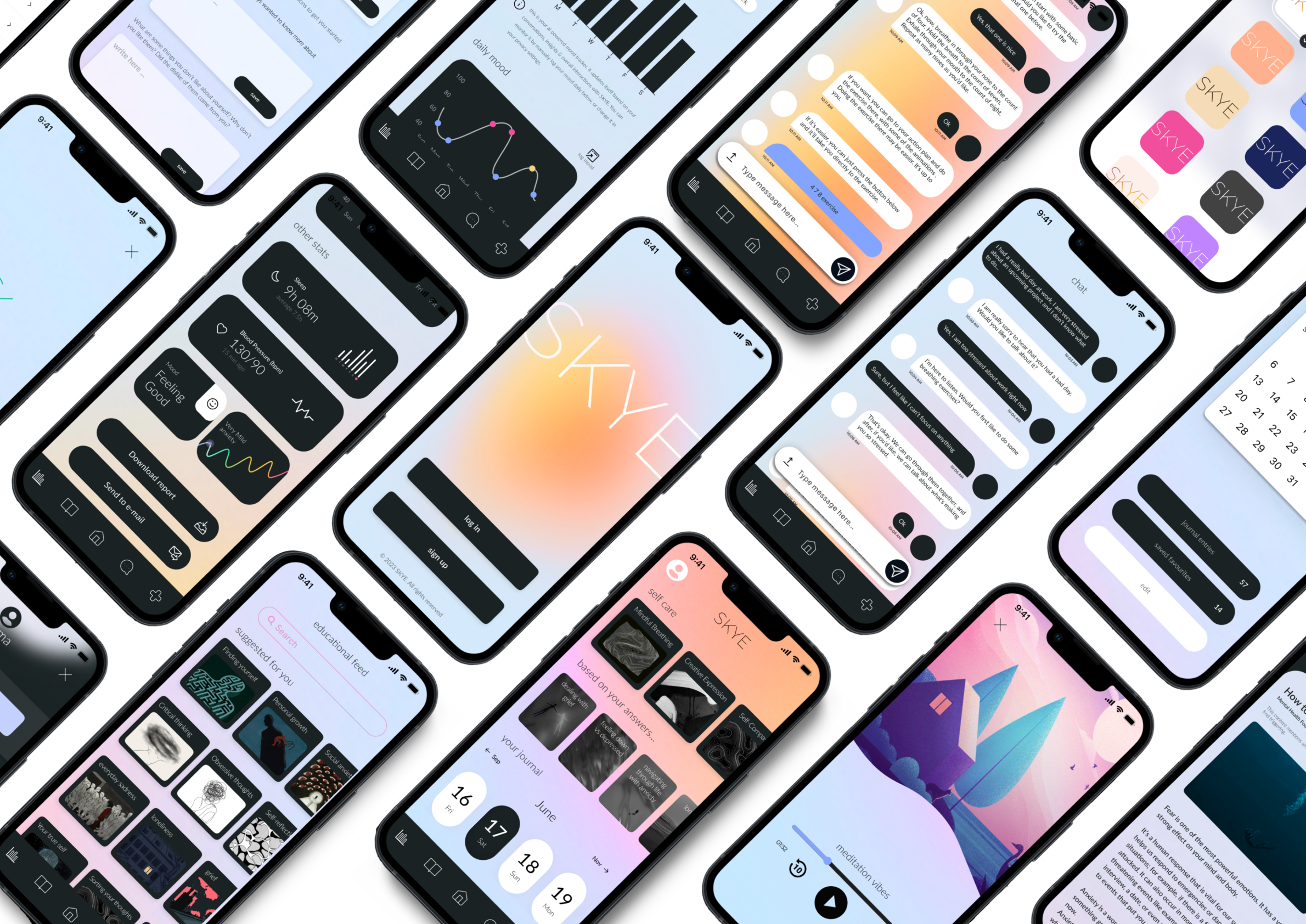
SKYE
UX Research | UX Design
Your mental health companion
Step into a new era of mental wellness where technology meets empathy. Experience personalized guidance and support like never before. Your journey to a healthier mind starts here.
Overview
Embarking on a mission to redefine mental health support, we’ve pioneered a cutting-edge service. By seamlessly integrating artificial intelligence and machine learning within a user-centered design, we aim to deliver personalized support to those who need it most.
Because in life’s toughest times, no one should face them alone.
Mikah Chavez
Emma Reige
— members
Lead UX Researcher
UX/UI Design Aid
Copywriter
— role
— duration
6 months
UX RESEARCH
Background
Over the last few years, mental health discussion and care have been increasingly taking center stage in people’s lives. We have seen a slow but steady push regarding the de-stigmatization of all discussions relating to mental health and are slowly becoming a lot more willing to seek professional help.
Although discussions around mental health and efforts to destigmatize it are gradually evolving, millennials and Gen Z emerge as the most receptive and proactive generations in seeking professional assistance. Nonetheless, their foremost obstacle lies in the escalating expenses associated with treatment and the scarcity of accessible resources at their disposal.
Understand: how does mental health affect these two generations and the limitations they face?
Know the numbers: what are health officials saying relating to the percentage of people being affected versus the percentage of medical care?
Learn from professionals: what are the common threads therapists/psychiatrists are seeing? What tools would we benefit from? What are some things we should be mindful of when working on this service?
Listen to real people: what do our users need? What are their pain points and their fears (if any) relating to AI?
Goals
How can we create a service that provides tools and information to these generations that are open to seeking help but face too many barriers when getting professional care?
Moreover, when involving Artificial Intelligence (AI) and Machine Learning (ML), how can we ethically utilize AI and ML to provide a tailored and personalized experience?
problem statement
Secondary Research on up-to-date information regarding mental health and available tools
Primary Research and ongoing collaboration with mental health professionals to understand how to best aid our users and provide real tools based on psychology as well as AI professionals to understand the models we were seeking
Market research to know existing services or tools that offer the same or similar aid as well as existing AI/ML models
In-depth user interviews with people from these two generations who struggle with their mental health and its management
Methodologies
Mental Health Professionals
Due to the sensitive nature of this topic, we felt it was utterly crucial to have ongoing communication and collaboration with mental health professionals for the success of this project. During the research phase, we interviewed professionals to get their input on topics that would be useful to tackle, topics we should avoid, and helpful therapy tools to best assist our users. Below are some insights and highlights:
During the course of a month, we conducted 20 1–2 hour interviews via Zoom. For our users to participate we asked that they were either Millennials or Gen Z, had some history of mental health struggles (current or past), and had them sign a consent form at the beginning of each interview acknowledging that they were free to end the interview at any time. To maximize anonymity, only one member of the team was present during the interviews and all notes taken were entirely void of identifiable information. Our users were asked about their mental health journey, how they coped with their struggles, if they had access to medical help, if they had used any existing apps/websites, and how they felt about AI being used to create this service. Below are some insights and highlights:
User Interviews
UX Design
Since user-centered/human-centered design was the backbone of our project, we went through several ideation sessions both with the help of the mental health professional as well as just the design team. Through these sessions we were able to clearly visualize what were were hoping to create, below are some outcomes of the sessions:
Ideation
The value pyramid along with an empathy map and context canvas played a notable role during our ideation process. By fully understanding our users’ core values and needs, we identified and categorized the most important functionalities and features that would offer the most significant value to our users.
After completing the customer journey analysis and several ideation sessions, we proceeded to develop the user flow. This allowed us to understand how the app would function before diving into the design phase, ensuring that each section was cohesive and every step was logical.
user Flow
Low-fidelity prototypes
For the initial prototypes, we created hand-drawn low-fidelity wireframes of the most important features, the MVPs. We explored these designs and discussed them with a mental health professional to ensure that SKYE included the necessary features identified by users during the initial interviews.
After assessing the information gathered from our ideation session with the psychologist using the low-fidelity prototypes, we conducted several iterative sessions within the design team. This allowed us to create mid-fidelity prototypes, which we then used in a small user test with five participants to ensure that our design choices were intuitive and that users were getting the tools they needed. Below, MVPs such as the home page, chat with SKYE for additional support, tracker/log, and a random activity are displayed:
High-fidelity prototypes
Usability testing
We conducted usability tests via Zoom with users from our original interview phase. Due to recent changes in prototyping software, we had to share our screen and have participants verbally guide the interviewer through the app. This allowed us to understand their thought processes, turning sessions into a mix of usability testing and co-creation, fostering a relaxed environment.
Our participants came from diverse backgrounds, including senior designers, UX designers, psychologists, and engineers. Although not explicitly addressed in the initial interviews, their specialized expertise brought valuable perspectives, enhancing the user experience and providing unique insights. This diversity helped identify well-executed design choices and areas for improvement based on their personal and professional viewpoints.
Usability testing Results
After analyzing the results, the design team broke the information into two categories with the accompanying iterations that needed to be made:
Overall usability of SKYE
Needed to address doubts within the library section
Reducing information overload for users in the library section
Enhancing the crisis management component
Insights based on the user’s background
Utilized the user’s background in order to co-create and iterate any additional solutions that may be needed
Psychology questionnaire and tools were discussed with participants having mental health background
Visual and interactive design were explored with users from a design background.
This approach yielded valuable insights into minor details, such as refining sentence phrasing to enhance user safety and care, providing suggestions for improving the security and data policy for a more transparent service, and even offering ideas for future elements of SKYE.
Key takeaways
Due to project constraints, the design team couldn't develop the AI model that would power SKYE, the backbone of the service. While we understand the importance of this component, limited resources prevented us from implementing the AI to see real results. However, we conducted extensive research using existing AI models to mimic SKYE's functionality, highlighting how we wanted our model to differ. Utilizing theoretical knowledge from secondary research on AI and ML, as well as insights from AI professionals, we shaped the solution. Nonetheless, the prototype and user testing of the service are limited by the unavailability of a properly trained AI model.
challenges
This project, which centered on mental health and AI, provided us with a firsthand understanding of the profound impact our work can have. Emphasizing human-centered design throughout, we gained invaluable insights into the ethical considerations of AI deployment and the critical importance of transparency at every stage. AI discussions often revolve around its capabilities and displacements, rather than its potential to address crucial issues like mental health. Our interviews afforded us the privilege of hearing deeply personal stories, entrusting us with sensitive information to create something meaningful for them. For me, this trust was the most rewarding aspect of the experience — knowing that someone believes in us to contribute positively to the world.

